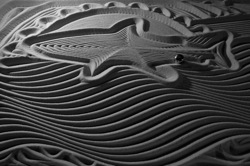A magazine where the digital world meets the real world.
On the web
- Home
- Browse by date
- Browse by topic
- Enter the maze
- Follow our blog
- Follow us on Twitter
- Resources for teachers
- Subscribe
In print
What is cs4fn?
- About us
- Contact us
- Partners
- Privacy and cookies
- Copyright and contributions
- Links to other fun sites
- Complete our questionnaire, give us feedback
Search:
Lines in the sand

Towards the end of his life, Alan Turing got interested in patterns in nature. He wondered how it was that so many unusual shapes, like spots, stripes and spirals, could appear on plants and animals. He thought the answer might be in chemistry. A certain kind of reaction, in which two chemicals can transform into one another, and then spread out over a larger area, could end up producing elaborate patterns. Over time, scientists have found clues that Turing might have been right.
An inventor in New York City called Michael Dubno doesn’t wait for nature to create patterns. He’s made an artwork called the Sand Table that draws complicated patterns within itself. The glass-topped table contains a pan filled with sand and one steel ball bearing a little smaller than a clementine. Underneath the sand is a series of motors that move a powerful magnet around. When the magnet moves, the ball bearing moves through the sand and creates complicated patterns and drawings. The whole thing is controlled by a computer program. The user can tell the magnet to draw abstract shapes like spirals, snowflakes and mazes, make words or draw animals.


